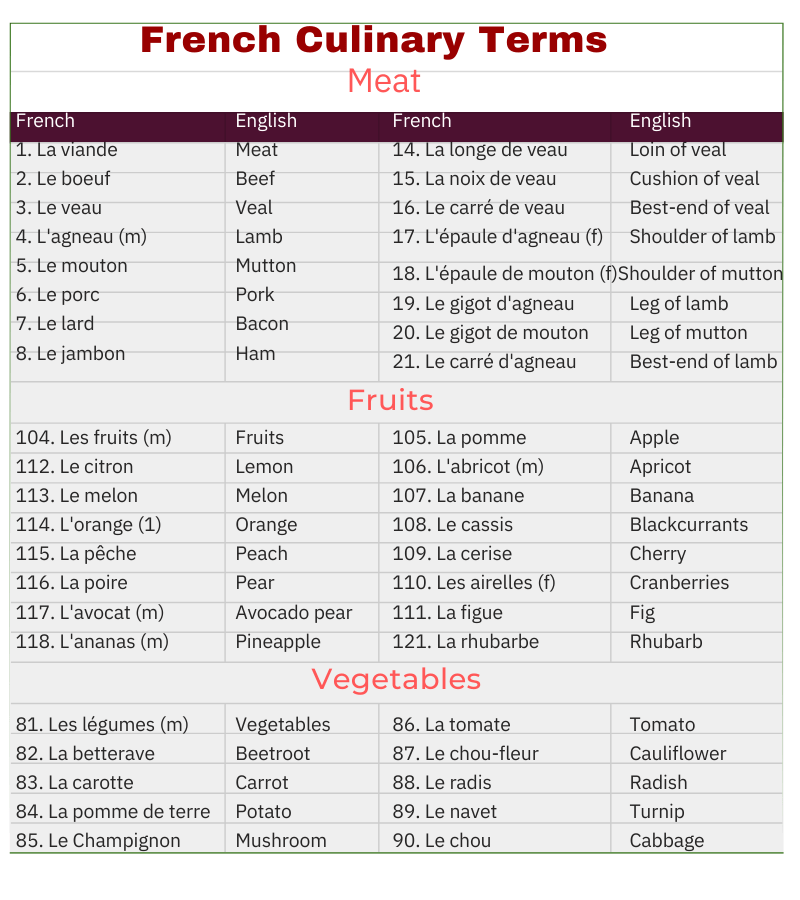Catering professionals and students must have a sound knowledge of the culinary and French terms that are very often found on menu cards and culinary books. Culinary terms are different from French terms and some French terms, especially culinary terms, can not be translated into English they should be written as they are.
Also, catering professionals should be able to understand French terms in order to explain the dishes to guests effectively. A working knowledge of French grammar and menu terms also facilitates in compiling the menu.
We will be discussing in this guide abut some culinary and French terms, French name of ingredient, and French name for some of the items used in restaurant.

Culinary and French terms:
| French Culinary Terms | Definition |
|---|---|
| 1. À la | In the style of – For example à la franchise, Which means dishes prepared in French style and à l’ anglaise, Which means dishes prepared in English style |
| 2. À la broche | Roasted on a spit |
| 3. À la créme | Lightly coated with cream |
| 4. À la diable | Highly seasoned dish |
| 5. aiguillette | Long thin slice of cooked meat cut from the breast |
| 6. Al dente | Term used for cooking pasta to the stage where it still retains the firmness of bite |
| 7. Au gratin | Dish sprinkled with bread crumbs and grated cheese and browned |
| 8. Amuses-bouches | Assorted cocktail canapés and small savouries |
| 9. Blanqutte | White stew cooked in stock |
| 10. Au bleu | Method of preparing freshwater fish, especially trout in a court bouillon which gives a blue tinge |
| 11. Ballotine | Boned and stuffed leg of poultry |
| 12. Baron | Double sirloin with the rumps of beef as a whole joint; also the whole saddle and two legs of lamb as one whole joint |
| 13. Beurre manié | Equal quantities of butter and flour kneaded together. It is used as a thickening agent |
| 14. Bombay duck | It refers to bummalo fish, native to the coastal waters of India. This fish is split, the central bone removed and sun-dried. It is used as an accompaniment with the Indian main course and also in the preparation of curries |
| 15. Blinis | A pancake made from buckwheat flour, used as an accompaniment with caviar |
| 16. Bündnerfleisch | Salt-cured and air-dried beef, cut into thin slices and served as an appetizer |
| 17. Charlotte | Hot or cold sweet dishes prepared in a mould lined with biscuits, fingers of sponge cakes, bread, and so on |
| 18. Chaud-froid | A sauce mixed with gelatin or aspic during the preparation and coated over the food and cooled to set |
| 19. Charcuterie | Pork products |
| 20. Cep | A type of mushroom |
| 21. Chanterelle | Trumpet-shaped yellowish mushroom with delicate flavour |
| 22. Compote | Stewed fruits |
| 23. Concassée | Peeled, pipped, and diced tomato |
| 24. Cordon | Thin line of sauce |
| 25. Civet | Brown stew prepared from game, usually hare |
| 26. Dariole | Deep, round mould with sloping sides |
| 27. Déjeuner | Lunch |
| 28. Petit-déjeuner | Breakfast |
| 29. Fécule | Starch such as corn flour, arrowroot, or potato flour |
| 30. Friandises | Alternative name for petits fours |
| 31. Fleurons | Small crescent-shaped pieces of puff pastry used for garnishing certain fish and vegetable dishes |
| 32. Fondant | Type of icing used in confectionery |
| 33. Haute cuisine | The finest high-class cookery |
| 34. Mirepoix | Roughly cut onions, carrots, celery, sprig of thyme, and bay leaf |
| 35. Morel | Type of mushroom having conical-shaped cap and good flavour |
| 36. Navarin | Brown stew made from lamb or mutton |
| 37. Natives | English oysters-the flat oysters raised in English waters |
| 38. Petits fours | Assorted small sweetmeats normally served at the end of the dinner or with tea : |
| 39. Pralin | Almonds are added to sugar while cooking at the caramel stage, cooled and crushed |
| 40. Prosciutto | Cured hams served raw, for example, prosciutto di parma (parma ham) |
| 41. Ragoût | A brown stew made from beef, carrots, brown stock, and brown roux |
| 42. Roux | A cooked mixture of equal quantities of butter and flour, used as a thickening agent |
| 43. Salmis | A brown-feathered game stew |
| 44. Sauerkraut | Shredded, pickled white cabbage |
| 45. Vol-au-vent | Small puff pastry case filled with savoury filling |
French names of ingredients:
| French | English | French | English |
|---|---|---|---|
| 1. La viande | Meat | 63. Le turbot | Turbot |
| 2. Le boeuf | Beef | 64. Le cabillaud | Cod |
| 3. Le veau | Veal | 65. L’aiglefin (m) | Haddock |
| 4. L’agneau (m) | Lamb | 66. Le merlan | Whiting |
| 5. Le mouton | Mutton | 67. La Sole | Sole |
| 6. Le porc | Pork | 68. La barbue | Brill |
| 7. Le lard | Bacon | 69. La limande | Lemon sole |
| 8. Le jambon | Ham | 70. La brème | Bream |
| 9. L’aloyau de boeuf (m) | Sirloin of beef | 71. Les crevettes grises (f) | Shrimps |
| 10. La côte de boeuf | Wing ribs of beef | 72. Les crevettes roses (f) | Prawns |
| 11. Le filet de boeuf | Fillet of beef | 73. La langoustine | Scampi |
| 12. La culotte de boeuf | Rump of beef | 74. L’écrevisse (f) | Cray fish |
| 13. Le cuissot de veau | Leg of veal | 75. Le homard | Lobster |
| 14. La longe de veau | Loin of veal | 76. La langouste | Crawfish |
| 15. La noix de veau | Cushion of veal | 77. Le crabe | Crab |
| 16. Le carré de veau | Best-end of veal | 78. Les huîtres (1) | Oysters |
| 17. L’épaule d’agneau (f) | Shoulder of lamb | 79. Les coques (f) | Cockles |
| 18. L’épaule de mouton (f) | Shoulder of mutton | 80. La coquille St Jacques | Scallop |
| 19. Le gigot d’agneau | Leg of lamb | 81. Les légumes (m) | Vegetables |
| 20. Le gigot de mouton | Leg of mutton | 82. La betterave | Beetroot |
| 21. Le carré d’agneau | Best-end of lamb | 83. La carotte | Carrot |
| 22. Le carré de mouton | Best-end of mutton | 84. La pomme de terre | Potato |
| 23. La selle d’agneau | Saddle of lamb | 85. Le Champignon | Mushroom |
| 24. La selle de mouton | Saddle of mutton | 86. La tomate | Tomato |
| 25. La côte d’agneau | Lamb chop | 87. Le chou-fleur | Cauliflower |
| 26. La côte de mouton | Mutton chop | 88. Le radis | Radish |
| 27. La côtelette d’agneau | Lamb cutlet | 89. Le navet | Turnip |
| 28. La côtelette de mouton | Mutton cutlet | 90. Le chou | Cabbage |
| 29. Le foie | Liver | 91. Le brocoli | Broccoli |
| 30. La volaille | Poultry | 92. L’artichaut (m) | Artichoke |
| 31. Le poussin | Baby chicken | 93. L’aubergine (f) | Egg plant |
| 32. Le poulet de grain | Small roasting chicken | 94. Le poireau | Leek |
| 33. Le poulet reine | Medium roasting chicken | 95. Les petits pois (m) | Peas |
| 34. La poularde | Large roasting chicken | 96. Les épinards (m) | Spinach |
| 35. Le dindonneau | Young turkey | 97. La laitue | Lettuce |
| 36. La dinde | Turkey | 98 L’oignon (m) | Onin |
| 37. Le caneton | Duckling | 99. L’asperge (1) | Asparagus |
| 38. Le canard | Duck | 100. Le concombre | Cucumber |
| 39. L’ole (f) | Goose | 101. L’échalote (f) | Shallot |
| 40. Le pigeon | Pigeon | 102. Le Persil | Parsley |
| 41. Le gibier | Game | 103. La menthe | Mint |
| 42. La venaison | Venison | 104. Les fruits (m) | Fruits |
| 43. Le lièvre | Hare | 105. La pomme | Apple |
| 44. Le lapin | Rabbit | 106. L’abricot (m) | Apricot |
| 45. Le faisan | Pheasant | 107. La banane | Banana |
| 46. Le perdreau | Partridge | 108. Le cassis | Blackcurrants |
| 47. La grouse | Grouse | 109. La cerise | Cherry |
| 48. La bécasse | Woodcock | 110. Les airelles (f) | Cranberries |
| 49. La bécassine | Snipe | 111. La figue | Fig |
| 50. La caille | Quail | 112. Le citron | Lemon |
| 51. Le canard-sauvage | Wild duck | 113. Le melon | Melon |
| 52. Le poisson | Fish | 114. L’orange (1) | Orange |
| 53. L’anchois (m) | Anchovy | 115. La pêche | Peach |
| 54. L’anguille (f) | Eel | 116. La poire | Pear |
| 55. Le hareng | Herring | 117. L’avocat (m) | Avocado pear |
| 56. Le maquereau | Mackerel | 118. L’ananas (m) | Pineapple |
| 57. Le saumon | Saimon | 119. La prune | Plum |
| 58. La truite saumonée | Salmon trout | 120. La framboise | Raspberry |
| 59. Les sardines (f) | Sardines | 121. La rhubarbe | Rhubarb |
| 60. La truite | Trout | 122. La fraise | Strawberry |
| 61. Le thon | Tuna | 123. Les oeufs (m) | Eggs |
| 62. Le flétan | Halibut | 124. La crème | Cream |
Menu terms used in a menu
| French | English | French | English |
|---|---|---|---|
| 1. Dubarry | Cauliflower | 8. Florentine | Spinach |
| 2. Clamart | Peas | 9. Veronique | Grapes |
| 3. Doria | Cucumber | 10. Parmentier | Potatoes |
| 4. Lyonnaise | Onion | 11. Princess | Asparagus |
| 5. Washington | Maize | 12. Jackson | Potatoes |
| 6. Singapore | Pineapple | 13. Provencale | Tomatoes and garlic |
| 7. Normandy | Apple | 14. Portugaise | Tomatoes |
French names for some of the items used in the restaurant:
| French | English | French | English |
|---|---|---|---|
| 1. La tasse | Cup | 10. Le pot au lait | Milk jug |
| 2. La soucoupe | Saucer | 11. Le sucrier | Sugar bowl |
| 3. Le couteau | Knife | 12. Le tire-bouchon | Cork-screw |
| 4. La fourchette | Fork | 13. La louche | ladle |
| 5. La cuiller | Spoon | 14. La passoire | Strainer |
| 6. La cuiller à soupe | Soup spoon | 15. La soupière | Sou[p tureen |
| 7. La cuiller à thé | Tea spoon | 16. La serviette | Napkin |
| 8. L’assiette (f) | Plate | 17. Le verre à vin | Wine glass |
| 9. Le verre | Glass | 18. Le verre à pied | Stemmed glass |
FAQ
What are French culinary terms?
French culinary terms refer to specific vocabulary used in French cooking that describe techniques, ingredients, and preparations. These terms are widely used in professional kitchens and culinary schools around the world.
Why are French culinary terms important?
Understanding French culinary terms is essential for anyone interested in cooking, especially in professional settings. Many cooking techniques and recipes originate from French cuisine, making these terms a vital part of culinary education.
Can you give examples of common French culinary terms?
Some common French culinary terms include “sauté” (to jump or fry quickly in a small amount of fat), “julienne” (to cut vegetables into thin strips), and “mise en place” (a French phrase meaning everything in its place, referring to the preparation and organization of ingredients before cooking).
How can I learn French culinary terms?
You can learn French culinary terms through culinary courses, cookbooks, online resources, and practice in the kitchen. Immersing yourself in French recipes and cooking techniques will also help reinforce your understanding of these terms.
Essential French Culinary Terms PDF download
Subscribe and join our community of hospitality professionals & students — get insights, tips, and the latest updates delivered straight to your inbox!







